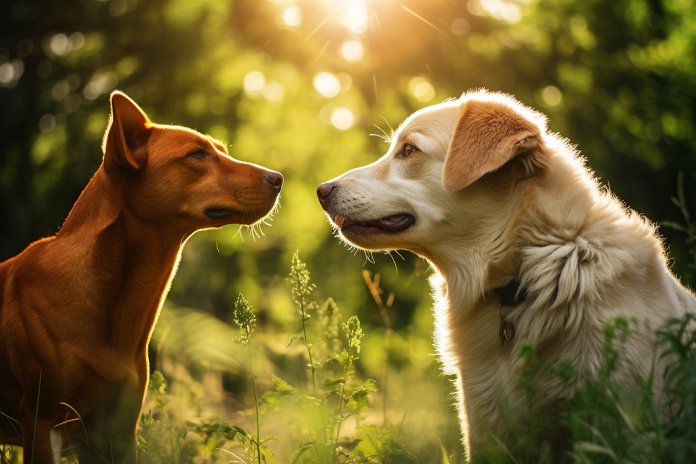
When our loved ones are unwell, as humans, we can easily recognize it through their behavior and communication. However, it is much more challenging to determine if our pets are sick. Dogs, in particular, show signs of illness, but these signs can be non-specific and easily mistaken for other reasons like boredom or a bad day.
Dogs Can Detect Illness in Other Dogs
While humans struggle to identify illness in their dogs, dogs themselves are highly efficient at detecting illness in both humans and other dogs. They have an incredible sense of smell that allows them to sniff out a wide range of health problems, from migraines to cancer. They can detect illness not by observing behavior, but by smelling something that indicates sickness.
Reactions of Dogs Detecting Illness
When a dog detects illness in another dog, their reactions can vary depending on the type and location of the illness. They may sniff around the affected area, lick it, or follow the ill dog more closely than usual. Some dogs may use body language to indicate a problem, such as paw tapping or spending a lot of time sniffing around the area. Licking is also a common way for dogs to display signs of illness.
Body Language and Other Signs
Additional signs that a dog has detected illness in another dog include staring, whining, raising a paw, and cuddling up or putting its head on the ill dog’s body. These behaviors indicate that the healthy dog senses something is wrong with the other dog.
History of Dogs Being Used to Sniff Out Illness
The remarkable sense of smell in dogs has been studied for many years. Dogs have been trained to use their sense of smell to detect illnesses in both humans and fellow canines. They have proven to be more efficient at detecting diseases in their early stages compared to high-tech equipment. Dogs have been utilized in various sectors, such as law enforcement and the military. They have shown their ability to sniff out a wide range of health problems.
Science Behind Dogs Smelling Illness in Other Dogs
Some dogs are specifically trained to detect illnesses from a young age, such as cancer in humans. They are exposed to blood samples from patients during training to familiarize themselves with the smell. However, even without training, dogs can pick up on changes and problems through their keen sense of smell. They can detect smells that are different from the norm.
Taking Note of Your Dog’s Behavior
Dogs used to detect illnesses go through rigorous training to identify the signs and smells associated with specific illnesses. They can then alert their owners through their behavior, signs, and body language. Institutions and studies now focus on training dogs to sniff out and identify diseases in other dogs. By observing changes in behavior and signs displayed by a healthy dog around an ill dog, owners can potentially catch serious conditions like cancer at an early stage. This could make a significant difference in the ill dog’s prognosis. If concerned, it’s best to contact a veterinarian for an examination.
Invaluable Warning Signs
Even without specialized training, dogs can pick up on unusual smells tied to certain conditions. Their ability to detect these smells can provide invaluable warning signs to their owners.
“Canine intuition: How dogs use their remarkable sense of smell to detect illness in fellow dogs”

Tips & Things to Know
1️⃣ Pay attention to your dog’s behavior and body language when it is around other dogs. Dogs have a keen sense of smell and can detect illness in other dogs, so if your dog is displaying unusual behavior such as sniffing a specific area or licking another dog, it may be a sign that the other dog is unwell.
2️⃣ Take note of any changes in your dog’s behavior or signs that it displays around other dogs. If your dog consistently acts differently around a particular dog, it could indicate that there is something wrong with that dog. Monitoring these changes can help you catch potential health issues early and seek veterinary care if necessary.
3️⃣ Dogs have been trained to detect illnesses in humans and can also pick up on unusual smells in other animals. While your dog may not have received specialized training, it can still provide you with a warning sign if it detects a strange smell associated with illness. If your dog consistently reacts to a specific dog or area, it may be worth contacting your vet to get the potentially ill dog checked out.
Frequently Asked Questions, Answered ✅
1. How can dogs detect illness in other dogs or humans?
Answer: Dogs can detect illness through their sense of smell, which is much more powerful than that of humans. They can sniff out a wide range of health problems, including cancer and migraines.
2. What are some signs that a dog may display when it detects illness in another dog?
Answer: Signs that a dog may display when it detects illness in another dog include sniffing at the affected area, licking the other dog, staring, whining, raising its paw, and displaying body language such as cuddling up or putting its head on the other dog.
3. Can dogs be trained to detect illness in humans?
Answer: Yes, dogs can be trained to detect illness in humans. They undergo rigorous training to familiarize themselves with the signs and smells associated with specific illnesses and can effectively identify the onset of those illnesses and alert their owners.
4. How effective are dogs at detecting diseases and illnesses in their early stages?
Answer: Dogs are believed to be more efficient at detecting diseases and illnesses in their early stages than much of the high-tech equipment used today. Their sense of smell allows them to pick up on changes and problems that may not be detectable to humans.
5. What should dog owners do if they notice unusual behavior or signs in their healthy dog around another dog?
Answer: If a healthy dog consistently displays unusual behavior or signs around another dog, it may be an indication that the other dog is unwell. Dog owners should monitor any changes in behavior and contact a veterinarian or schedule an appointment to have the potentially ill dog checked out. Early detection of serious conditions such as cancer can make a significant difference in the outcome for the ill dog.